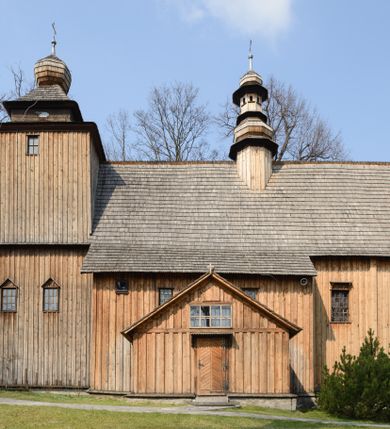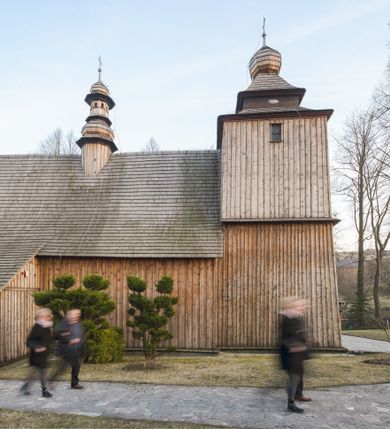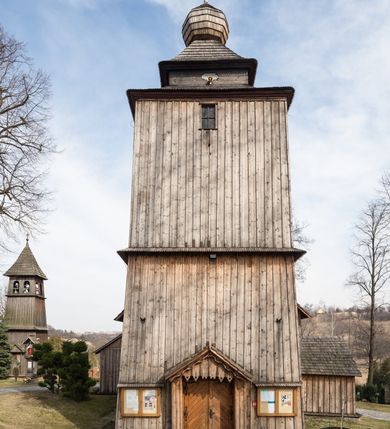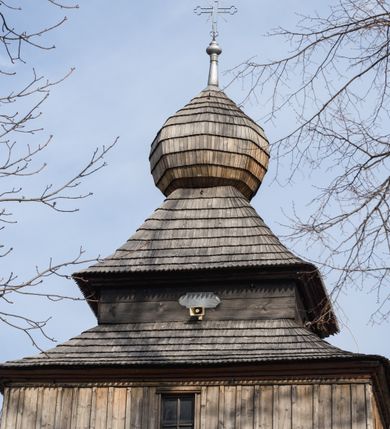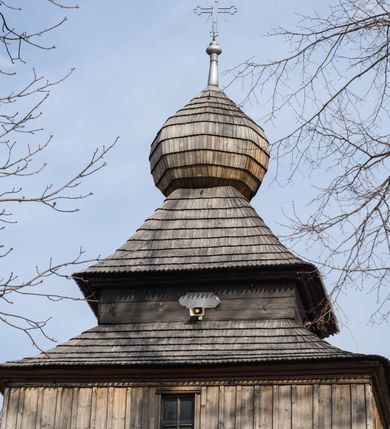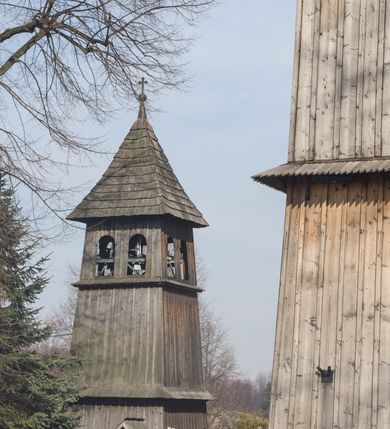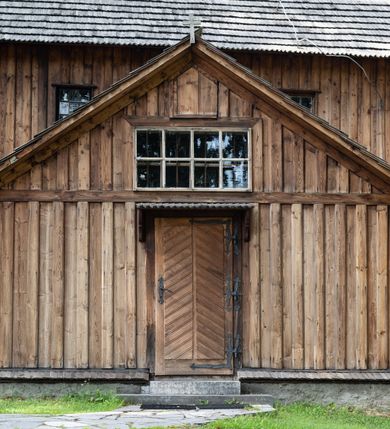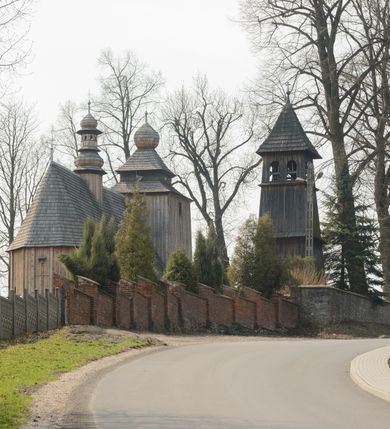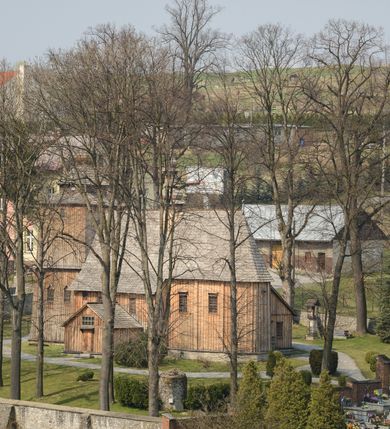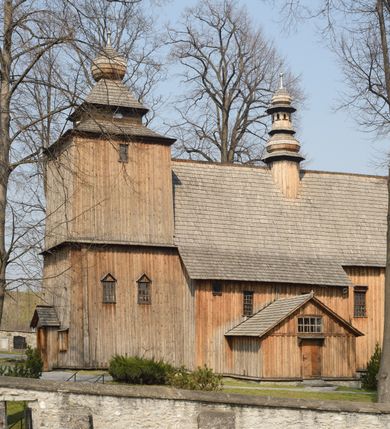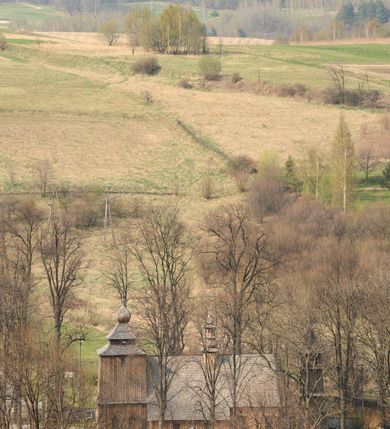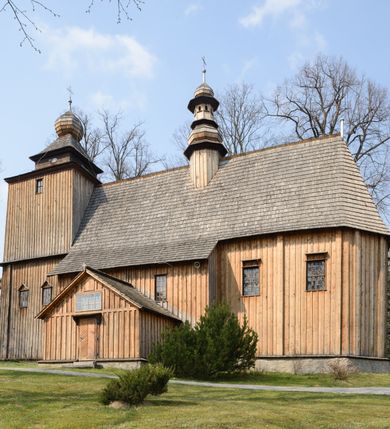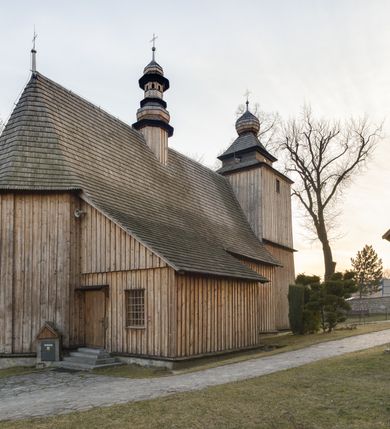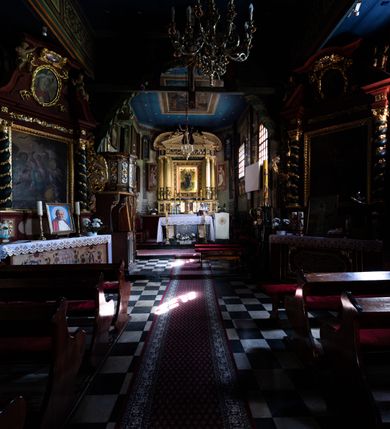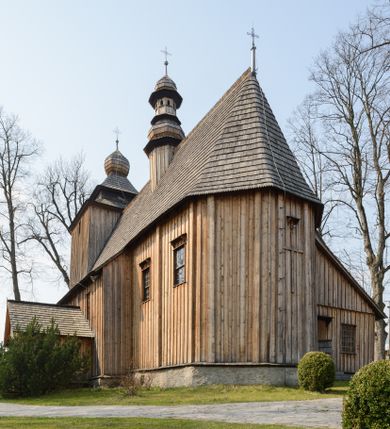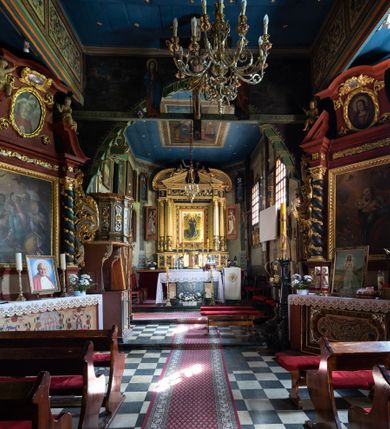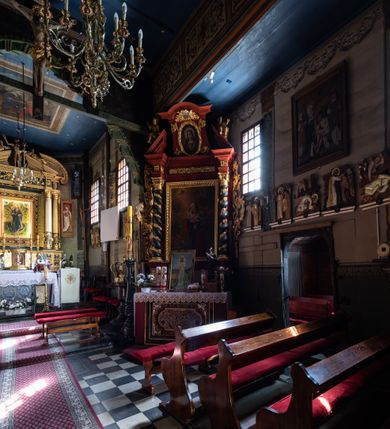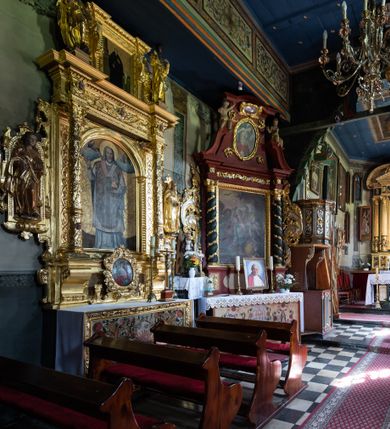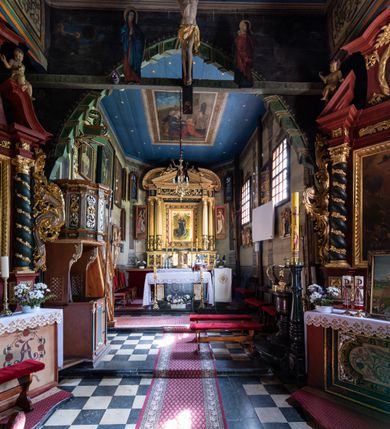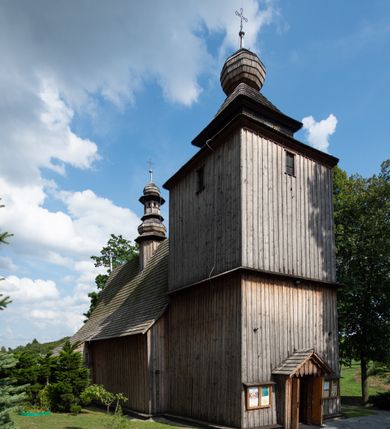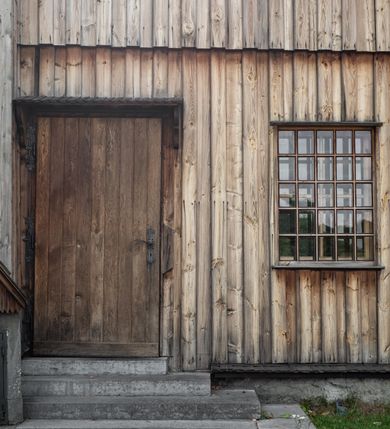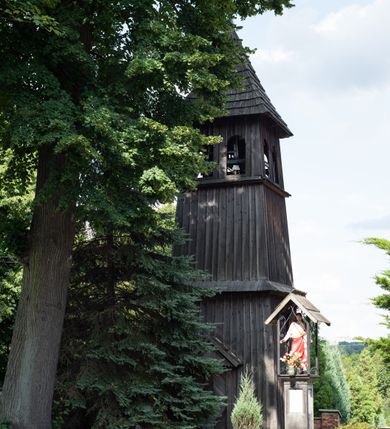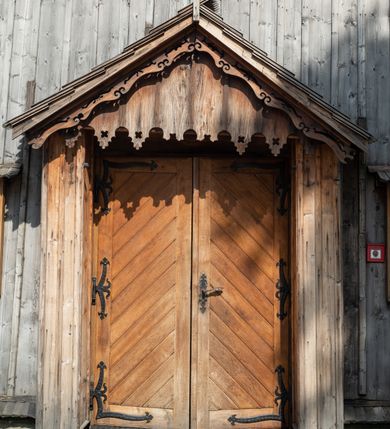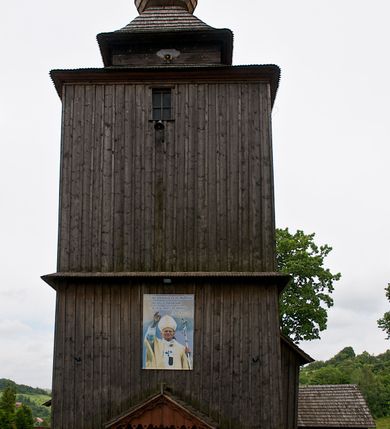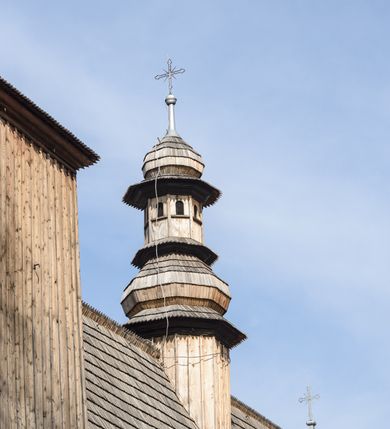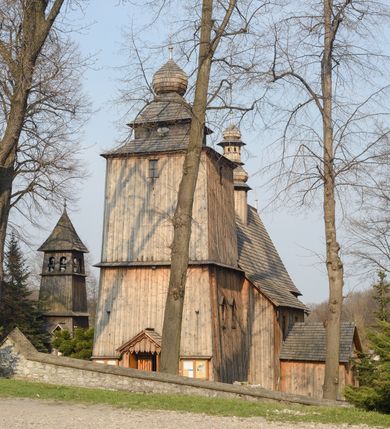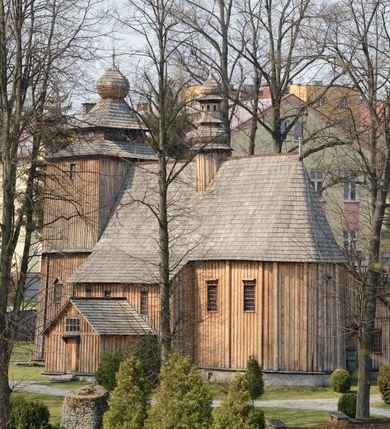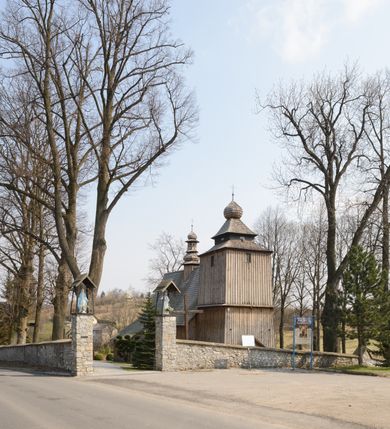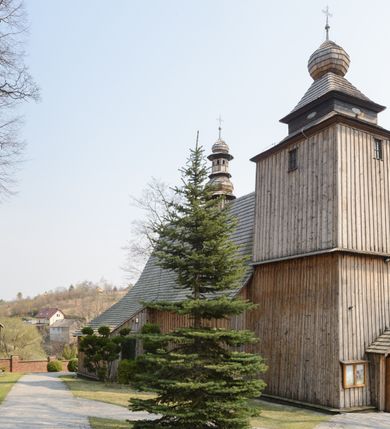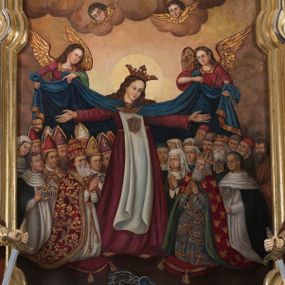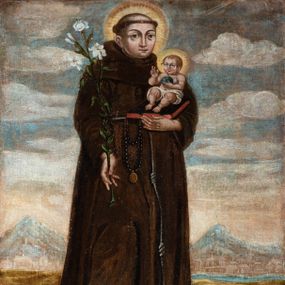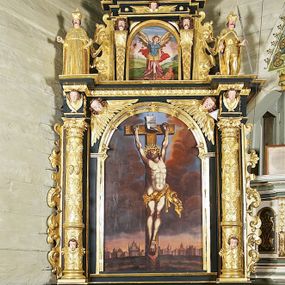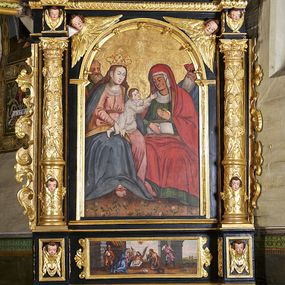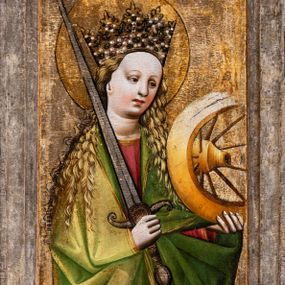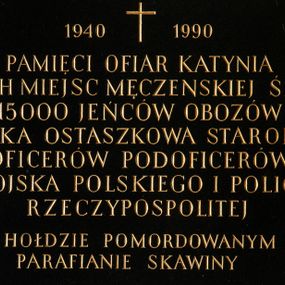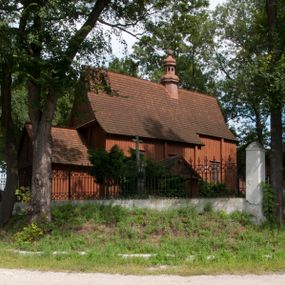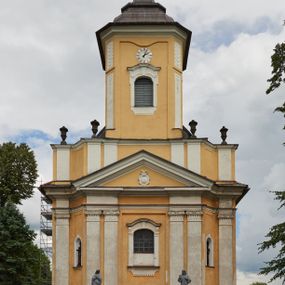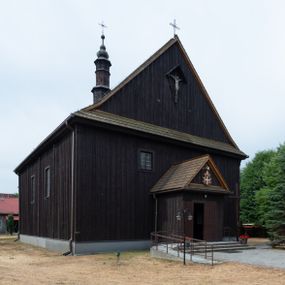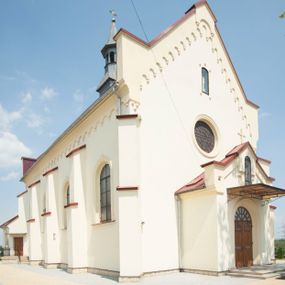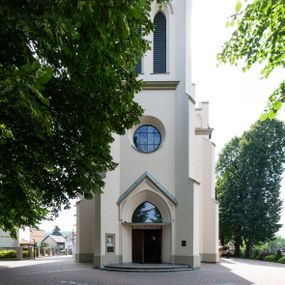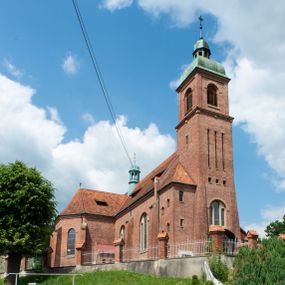
Church of the Visitation of the Blessed Virgin Mary
Identifier
DZIELO/12571
Amount
1
Catalogue note author
Justyna Kuska
History of work
The present church in Paczółtowice is probably the second temple built in this place. The previous one, also wooden, already existed before 1335 and was built from the foundation of the village owners of the Toporczyk family, who then took the name Paczółtowski after the name of the village. The building, still standing today, was built around 1515, as evidenced by dendrochronological analysis of nave walls and tower structure carried out in 1996. The funder of the building is unknown. Most probably, it was a member of the Paczółtowski family, who owned the village until 1529 when Jan Zembrzycki sold Paczółtowice to his cousins, Tęczyński brothers: Andrzej the Voivode of Cracow and Jan the Voivode of Belz. The village was in the hands of the Tęczyński family until the 1570s when, as a result of two transactions, it became the property of Szczęsny Czerski of the Rawicz coat of arms. Before 1595 Elżbieta, daughter of Szczęsny Czerski, married Castellan of Inowłódz, Stanisław Tarnowski of Rola coat of arms, and brought him Paczółtowice in the dowry. Before 1605, after his death, she got married again to the Starost of Lityn, Piotr Łaszcz of the Prawdzic coat of arms. After her death in 1617, a period of complicated changes in ownership began. It lasted for a dozen or so years and ended with the purchase of the village by Jan Magnus Tęczyński, who bought it on behalf of his sister Agnieszka Tęczyńska-Firlej. Agnieszka Tęczyńska-Firlej, the funder of the Discalced Carmelites hermitage in nearby Czerna, gave it to the local Carmelites in 1631 as an endowment for the monastery. They owned the village until 1950, when the church and monastery property was nationalized. The church in Paczółtowice underwent numerous transformations over the centuries. The quadrilateral bell tower was added to the structure of the temple in 1528. Until the third quarter of the 18th century, the church was surrounded by arcatures, after the liquidation of which shingles on the edges of the walls were replaced with formwork. The original architectural elements from the first quarter of the 16th century include: window frames in the nave, profiles of beams in the lowered parts of the ceiling in the nave and the loft, the frame of the chancel entrance and the southern portal. During the ministrations of the parish priests Wojciech Kordkowicz (1643-1675) and Andrzej Strzałkowski (1675-1683), the church was rebuilt, new furnishing was purchased, and in 1679 a new presbytery was built. Many foundations were established on the initiative of Adam Negowicz from Łęka, the manager of the marble quarry in nearby Dębnik, and thanks to his financial support. In 1648 the temple was rebuilt on his request. The wooden ground beams were replaced with underpinning, a marble floor was laid, a tomb crypt was made, the roofing was repaired, and a brick fence was erected in place of the hoarding around cemetery. Between 1648 and 1663, also from the Negowicz foundation, a polychrome was made, the fragments of which have survived to this day on the northern wall of the chancel and the nave (behind the mannerist altar of St. Nicholas). During the reign of Augustus III, probably during the ministration of parish priest Jan Warmski (1756-1758), another renovation of the church took place. What influenced the image of the temple the most was the liquidation of the surrounding arcatures. Then, in addition, the ridge turret, preserved to this day, was erected and the coping of the bell tower was renovated to give it its current Baroque shape. In the second half of the 18th century the condition of the church systematically deteriorated, and at the end of the century it was so bad that the Carmelites from Czerna considered building a new temple. The only significant investment at that time was the construction of a new presbytery in 1789 by the parish priest Marcin Szczurowski. However, the construction of a new church did not take place. The authorities of the Republic of Cracow, in which Paczółtowice was included after the Congress of Vienna, ordered the Carmelites to carry out a general renovation of the temple. It began in 1819 and was financed half by the monastery in Czerna and half by parish funds. Józef Simek, a carpentry foreman from Krzeszowice, managed the works carried out until 1820. The windows in the chancel were then enlarged removing the late Gothic frames cut into an ogee arch and the late Gothic rood beam. During the ministry of the parish priest Adam Wójcikiewicz (1849-1873), the Baroque polychrome and altars were renovated and the church cemetery was extended. Then, during the ministrations of parish priests Stanisław Mąkowicz (1873-1888) and Andrzej Kapturkiewicz (1889-1912), works which decided about the current appearance of the temple in Paczółtowice were carried out. In 1878, the bell tower was renovated, eliminating the so-called ogee arch of the late Gothic portal. - In 1889 the present sacristy was built and 10 years later the southern porch was erected. In the years 1894-1896 painter Jan Stankiewicz made a polychrome of the church, which was preserved till this day. At the end of the 1920s, thanks to the funding which the parish received through Stanisław Stachowski's will, the idea of building a new temple was revived. Even the groundworks began and continued until 1931, but the church was not built after all. Between 1936 and 1937 a parish house was built. After the outbreak of World War II, Paczółtowice was incorporated into the General Government. In 1942, the German authorities requisitioned the historic bell from 1530. Despite the toils of occupation, the high altar with a Gothic painting of Our Lady of the Immaculate Conception and the side altar of St. Joseph were renovated by Józef Ryłko in 1943. After the end of the war, in 1945-1948, the construction of the temple was reinforced, the organ was repaired and successful efforts were made to electrify the building, using Stanisław Stachowski's testamentary trust and parishioners' contributions. On September 27, 1947, conservators decided to consider the church in Paczółtowice a historic building. Important events in the history of the temple in the 1960s were the purchase of two new bells ordered from the Felczyński foundry, which were consecrated in 1960 by the then Bishop of Cracow Karol Wojtyła, and the construction of a free-standing bell tower in 1968. At the beginning of the 1970s, the Monuments Conservation Office in Cracow prepared detailed technical documentation including an expert's opinion on the technical condition of the building and an architectural survey together with graphic and descriptive documentation for the intended renovation of the temple. Its scale and costs, however, exceeded the financial capacities of the parish at that time, so it was limited to minor renovation works of, for example, the wall of the church cemetery and shingle roofing of the church and the sacristy. In the 1980s, conservation works were also carried out on some elements of the furnishing of the church, such as the altar of St. Nicholas and the epitaph plaque of Adam Negowicz. However, it was not possible to obtain any state subsidies for the renovation of the church. In 1983, the idea of building a new temple returned once again. It was even accepted by the Metropolitan of Cracow Franciszek Macharski, however, it met with strong opposition from the conservation community concerned about the condition of the historic building. The idea of building a brick temple was finally abandoned in the early 1990s, and, in return, the efforts of the parishioners and the then parish priest Jan Kopytko focused on carrying out a major renovation of the church and most of the historic furnishing of the temple. These works were carried out in the years 1991-1996.
Abstract
Church of the Visitation of the Blessed Virgin Mary in Paczółtowice is a building of modest size and architectural forms. The wooden, single-nave temple with a square tower in the facade is probably the second church erected in this place. The previous one, also wooden, existed before 1335 and was built from the foundation of knightly family of Toporczyk. The building, existing until today, was erected around 1515. The tower was added in 1528. The funder of the building is unknown. Most likely, it was one of the representatives of the family in Paczółtowice, who were the land owners of Paczółtowice until 1529. Particular attention should be paid to rich furnishings of the temple, originating from different eras. With regard to the medieval furnishings of the church, a late gothic crucifix has been preserved, originally placed on a rood beam, a painting of Our Lady of the Immaculate Conception, currently placed in the baroque high altar, and paintings of Saint Catherine and Saint Barbara (on the obverses) and Gabriel the Archangel and the Virgin Mary (on the reverses). Originally, these paintings constituted an independent triptych intended to be placed on the altar. It was created in the years 1460-1470, in a workshop of an anonymous painter from Cracow. The monuments from the first half of the 16th century include a baptismal font made of bronze in 1533 and a bell from 1535 – pendant now in a new, modern bell tower located on the former church cemetery, as well as a metal-clad door from the chancel to the sacristy. The remaining furnishings of the church are mainly baroque works created in the 17th and 18th centuries. The high altar of black Dębnik limestone (the so-called black Dębnik marble) was built at the beginning of the 17th century and probably funded by the village owners – Elżbieta née Czerska (d. in 1617) and her husband Stanisław Tarnowski, coat of arms Rola (d. in 1606). During the Baroque era, the mensa of the high altar received an antependium made of black Dębnik marble, most probably made in the mid-17th century by Wojciech or Jacek Zielaski – stonemasons associated with the nearby quarry in Dębnik. In the eastern corners of the nave there are two baroque altars with a similar structure, created before 1728. From the north, it is the altar of Saint Joseph. The south-eastern corner of the nave is occupied by the altar of Saint Joachim and Anne. At least from the first half of the 19th century, the church has a fourth altar – the mannerist reredos of Saint Nicholas. According to tradition and older studies, it was transferred to the church in Paczółtowice from the Wawel cathedral. This information, however, is not confirmed by any source. The 18th-century furnishings of the church are completed by a pulpit with a confessional placed on the northern wall of the chancel from the first quarter of the 18th century (before 1728) and an organ front from the same period. One of the most valuable monuments of painting preserved in the church in Paczółtowice is a votive image from the beginning of the 16th century (around 1510-1515), depicting Christ waiting for Passion in the surroundings of Our Lady of Sorrows, Saint Stanislaus and Saint Stephen, made in the workshop of Lesser Poland, probably by Cracovian painter Marcin Czarny or his son, Mikołaj. Another precious paintings include the depiction of the patron of stonemasons – Pope Clement I (from 1741), as well as paintings depicting Christ in the Mystical Winepress from the second half of the 17th century and the crucifixion with Mary and Saint John the Evangelist from the turn of the 17th and 18th centuries, enlarged, repainted and reframed in the second half of the 18th century. In the church porch one can see a group of small baroque statues representing various saints. Their authorship and origin are unknown. A separate group of monuments from the second half of the 17th century are objects made of so-called black Dębnik marble. These include a paschal candle holder, the aforementioned antependium of the high altar, a lavabo in the sacristy, an engraved plaque with an invocation to the Virgin Mary and a group of epitaph plaques located in the western section of the wall surrounding the temple, i.a. the epitaph plaque of Adam Negowicz – a stonemason and donor of the temple, which was located inside the church before 1747. The above-mentioned objects were made in a workshop of stonemason-engravers from the Zielaski family operating in Dębnik.
Persons related to work
Other works from this place
Similar works
How to cite?
Justyna Kuska, "Church of the Visitation of the Blessed Virgin Mary", [in:] "The Sacred Lesser Poland Heritage", 2026, source: https://sdm.upjp2.edu.pl/en/works/church-of-the-visitation-of-the-blessed-virgin-mary
